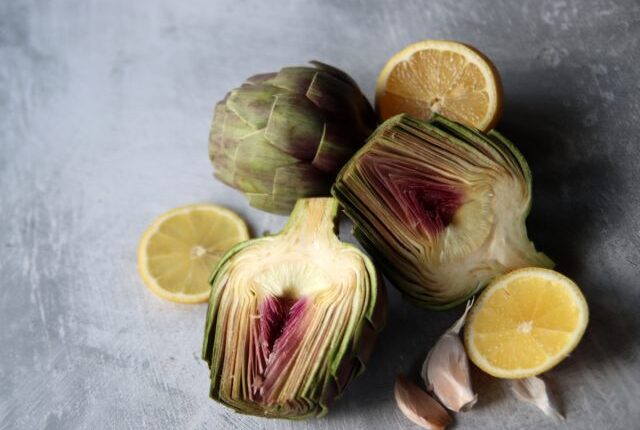Vegetables are rich in essential nutrients that our bodies need to stay healthy. They provide us with dietary fiber, antioxidants, phytonutrients, as well as a variety of important vitamins and minerals. These nutrients are beneficial for our overall well-being, helping us to maintain good health and prevent diseases. Studies have indicated that consuming a diet that is abundant in vegetables can reduce the likelihood of developing certain health issues such as heart disease and stroke.
Despite their stellar health benefits, less than 10% Americans are eating the recommended servings of vegetables per day. As a registered dietitian who is an equal opportunity vegetable lover, I’m here to help change this. In this deep dive, I’m sharing 10 of the healthiest vegetables I recommend my clients eat on the regular and the science supporting why they’ve got the street creds to make this list! Plus, I’ll share a few simple ideas to help you break out of your comfort zone and show you how to add them to your meal plan this week. Read on, and for more tips on what to eat, check out The 30 Healthiest Foods to Eat Every Day.
10 Healthiest Vegetables
Artichokes
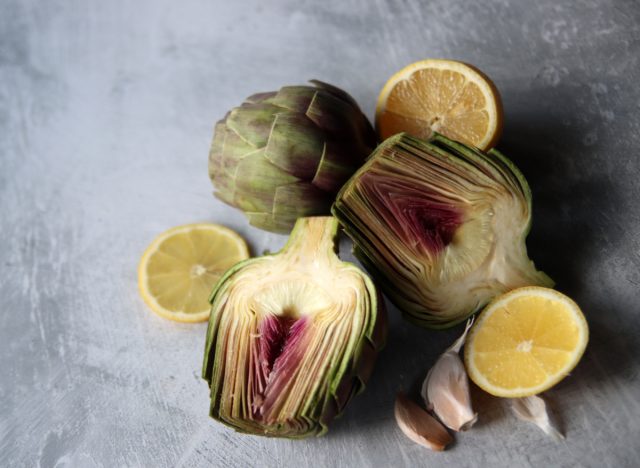
Nutrition (Per ½-cup):
Calories: 45
Fat: 0 g (Saturated Fat: 0 g)
Sodium: 50 mg
Carbs: 10 g (Fiber: 5 g, Sugar: 1 g)
Protein: 2 g
Hands down my favorite vegetable of all time is the artichoke. While it might look intimidating at the market, let me assure you, it delivers big time on nutrition. Whether you prepare it from a fresh crop or stock up on frozen or canned artichoke hearts (my personal favorites), you are providing your body with one BIG nutritional bang per bite.
Artichokes are among the highest-fiber vegetables, packing 5 filling grams in a ½-cup serving of cooked artichoke hearts. Plus, research has shown their high fiber content can aid weight loss, while their antioxidants and phytonutrients support immune health and decrease one’s risk for heart disease.
If you’re new to artichokes, start simple with canned artichoke hearts—my go-to is from Trader Joe’s—packed in water to keep fat and calories in check. Finely chop them and add them to pasta, salads, or quiches to enjoy their nutrient-packed benefits.
Beets
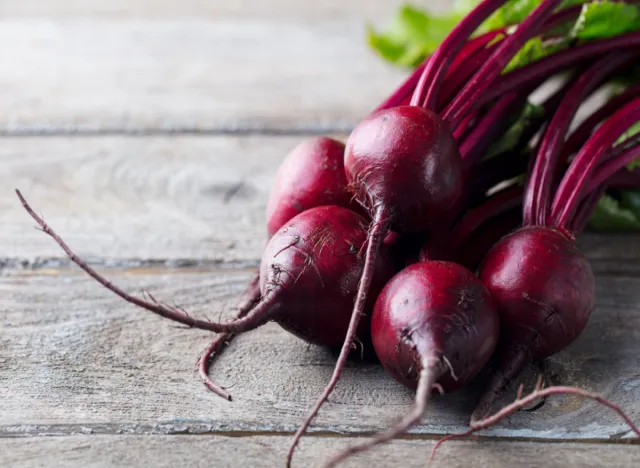
Nutrition (Per ½-cup):
Calories: 37
Fat: 0 g (Saturated Fat: 0 g)
Sodium: 65 mg
Carbs: 8.5 g (Fiber: 2 g, Sugar: 7 g)
Protein: 1 g
A love-it or hate-it food due to their earthy flavor profile, beets rank in my top 10 of healthiest vegetables. Packed with fiber and antioxidants, they offer a range of benefits for total body health. While beets come in both a golden and red color, my favorite is the red. Within the beautiful red and purple hues lies important phytonutrients that help lower inflammation, neutralize free radicals with antioxidant action, and support gut and heart health. In fact, red beets provide such a wonderful antioxidant profile they are often incorporated into the diets of athletes to improve athletic performance and aid recovery.
Sure, you can roast them or buy them pre-cooked and add them to a delicious salad with some goat cheese and walnuts, but you can also puree them into smoothies (they go wonderful with cocoa powder) or enjoy the juice as a quick recovery beverage.
Brussels Sprouts
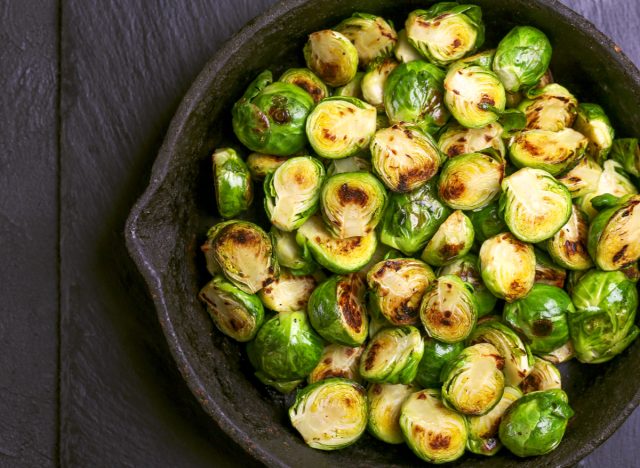
Nutrition (Per 1 cup):
Calories: 65
Fat: 1 g (Saturated Fat: 0 g)
Sodium: 23 mg
Carbs: 13 g (Fiber: 6 g, Sugar: 3 g)
Protein: 6 g
Brussels sprouts are no longer just your grandma’s vegetable—they’ve made a well-deserved comeback! It’s about time, especially considering their nutrient density. Not only does 1 cup of Brussels sprouts pack 6 grams of filling fiber, but they are relatively low calorie, with just 65 calories total in that same serving.
One of Brussels sprouts’ most notable health benefits comes from a compound called glucosinolate. During cooking, this phytonutrient is broken down into something called isothiocyanates. This compound has shown to have protective effects on cells and demonstrate anti-cancer properties, making Brussels sprouts a valuable addition to a diet focused on disease prevention.
In the kitchen, Brussels sprouts are incredibly versatile.. Not only can you air fry then for a quick and delicious side, but you can also roast them with your favorite sheet pans meals, or simply pick up a convenient salad kit to reap their nutritional benefits.
Carrots
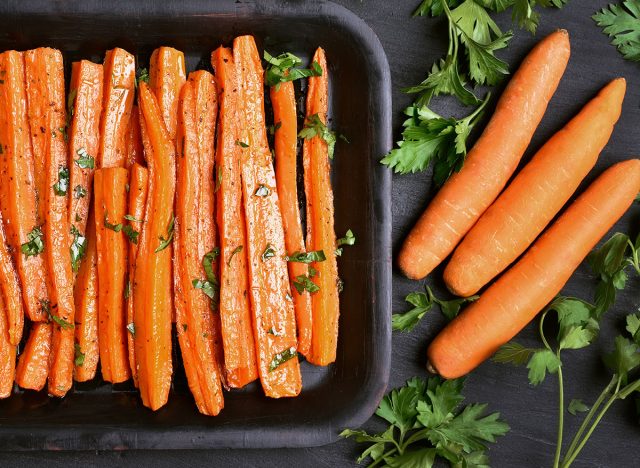
Nutrition (Per 1-cup sliced):
Calories: 50
Fat: 0 g (Saturated Fat: 0 g)
Sodium: 84 mg
Carbs: 12 g (Fiber: 3 g, Sugar: 6 g)
Protein: 1 g
Carrots are a convenient snack that easily help you achieve your recommended daily dose of vegetables. Plus, they’re affordable and versatile, making them a realistic addition to almost any budget or meal plan—because healthy eating should be accessible to everyone! Whether you’re turning them into energy bites or tossing them in salads or soups, carrots are a delicious way to sneak more nutrition into your diet.
Nutritionally speaking, carrots are low in calories and provide a decent source of fiber with 3 grams in a 1-cup serving of carrot sticks. Plus, they’re a great way to get beta-carotene and antioxidants like lutein and zeaxanthin, which support vision and eye health, especially as you age.
If you need any more reason to nosh on a carrot stick, some research suggests that their vibrant orange hue may be linked to reductions in visceral and liver fat, along with improved insulin sensitivity. That said, eating too many carrots can lead to carotenodermia, a harmless condition that gives your skin an orange-yellow hue, so if you notice a change, it might be time to cut back!
Edamame
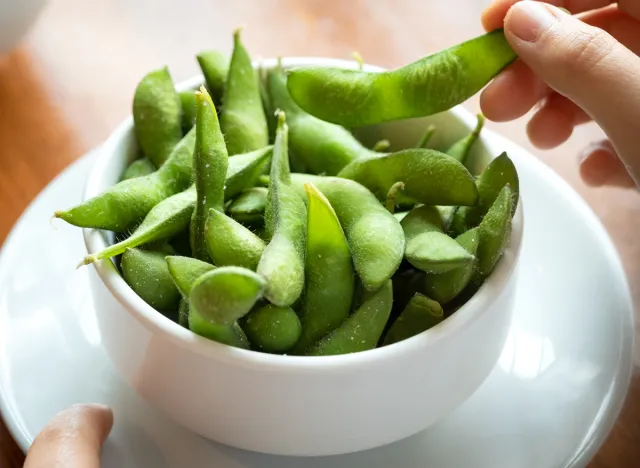
Nutrition (Per 1 cup):
Calories: 190
Fat: 8 g (Saturated Fat: 1 g)
Sodium: 9 mg
Carbs: 14 g (Fiber: 8 g, Sugar: 3 g)
Protein: 18 g
One of the best hacks for meeting both your vegetable and protein needs is to lean into foods that cover both categories. Case in point: beans and legumes! Edamame is a soy food that is rich in both fiber and protein. A 1-cup serving of edamame yields 8 grams of filling fiber and 18 grams of powerful protein. Remember, fiber keeps you fuller for longer, supporting weight loss. Plus, edamame also packs potassium which aids blood pressure. Research shows consuming high potassium foods like edmame may help lower blood pressure. Eating edamame may also help lower cholesterol and breast cancer risk, improve menopausal symptoms, and protect bone health.
To enjoy these benefits, you also don’t have to work to hard in the kitchen. From snacking on roasted, lightly salted edamame to tossing a cup into bowls or stir-fries, it’s an easy addition to your routine.
Mustard Greens
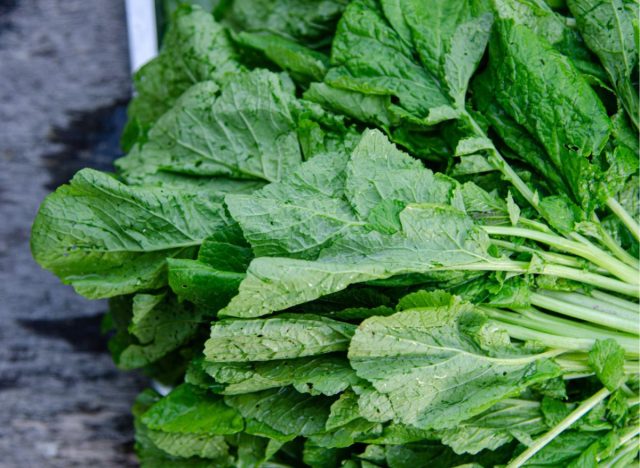
Nutrition (Per 1-cup cooked):
Calories: 36
Fat: 1 g (Saturated Fat: 0 g)
Sodium: 13 mg
Carbs: 6 g (Fiber: 3 g, Sugar: 2 g)
Protein: 4 g
Ranking among the healthiest greens, mustard greens are a staple in many cultural cuisines. While they may be an acquired taste, their nutrient profile earns them a spot as one of the top 10 healthiest vegetables. A 1-cup serving of cooked mustard greens provides 3 grams of fiber, 4 grams of protein, and is low in calories. Cooking them with a bit of oil and pairing them with a protein source, like canned beans or lean pork, creates a nutrient-dense, complete meal.
Mustard greens also deliver a hearty dose of phytonutrients, including important antioxidants that benefit immune health, eye health, and more. Thanks to their stellar source of vitamin C, you better not sleep on adding them into your meal plan, especially as cold and flu season creeps in.
Peas
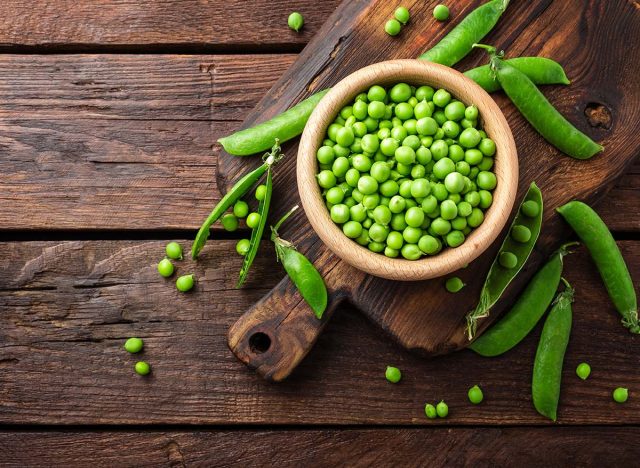
Nutrition (Per 1 cup):
Calories: 70
Fat: 0 g (Saturated Fat: 0 g)
Sodium: 6 mg
Carbs: 11 g (Fiber: 4.5 g, Sugar: 6 g)
Protein: 5 g
Peas are another tiny but mighty vegetable that deliver a solid source of both protein and fiber. You can find peas in various forms—fresh in the produce aisle, or conveniently packaged as canned or frozen options. Classified as a starchy vegetable, fresh peas make a great addition to your diet, while dried split peas count in both the vegetable and plant protein categories.
The dynamic nutrient profile of peas makes them a valuable addition to any diet, not only for addressing nutrient deficiencies but also for their potential health benefits. Packed with phytochemicals, peas have been shown to offer anticarcinogenic effects, help lower cholesterol, and support the body’s defense against free radicals through their antioxidant properties.
And, the best part, peas are so easy to add to your diet. You can pop open a can, rinse under cool, running water to reduce the salt content, and toss into a blender with your favorite herbs and species to create a sauce for pasta or delicious dip to enjoy with those carrots. Or, simply toss into your soups or salads.
Spinach
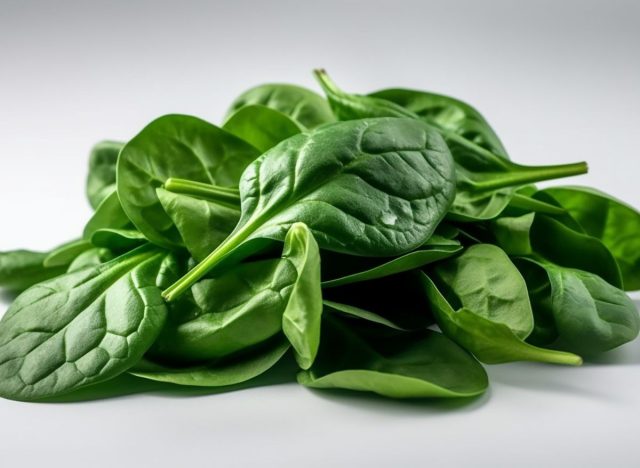
Nutrition (Per 1 cup):
Calories: 7
Fat: 0 g (Saturated Fat: 0 g)
Sodium: 24 mg
Carbs: 1 g (Fiber: 1 g, Sugar: 0 g)
Protein: 1 g
This classic leafy green has earned its place among the healthiest options on the market. I am loyal to this vegetable as I find it so easy to use in both sweet and savory dishes alike. Blend it into smoothies, bake it into muffins or pancakes, or toss it into soups and salads to give your meals a nutritional boost. After all, it’s relatively low calorie and packs 1 gram of protein and fiber in every cup!
Spinach is also a heart-healthy superstar. In fact, research shows the dietary nitrate found within it’s leaves supports heart health by lowering blood pressure. Since it’s also very lightweight, you can really volumize with this vegetable to make it work for your meal plan.
Sweet Potatoes
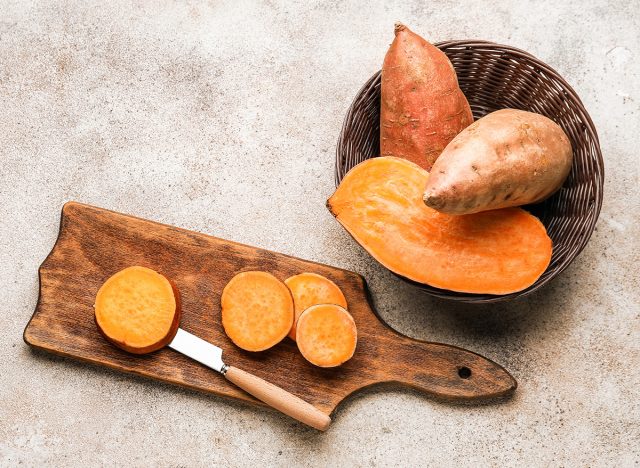
Nutrition (Per 1 medium potato):
Calories: 103
Fat: 0 g (Saturated Fat: 0 g)
Sodium: 41 mg
Carbs: 24 g (Fiber: 4 g, Sugar: 7 g)
Protein: 2 g
Sweet potatoes are often compared to regular potatoes, but they’re actually completely different crops. While potatoes are edible tubers, sweet potatoes are large edible roots that offer their own unique nutritional benefits.
While both offer a solid source of nutrients, sweet potatoes shine when it comes to their antioxidant content and beta-carotene, a precursor to vitamin A that supports eye health. Research also shows they boost immune health with their antioxidants and promote gut health with 4 grams of filling fiber per medium serving.
Though commonly served during the winter holidays, sweet potatoes are available year-round and can be incorporated into a variety of dishes. From sweet potato fries and chili to breakfast parfaits, there’s a recipe for everyone to enjoy this nutrient-packed food. (Fun fact: “Sweetpotato” is the correct spelling used by growers!)
Watercress
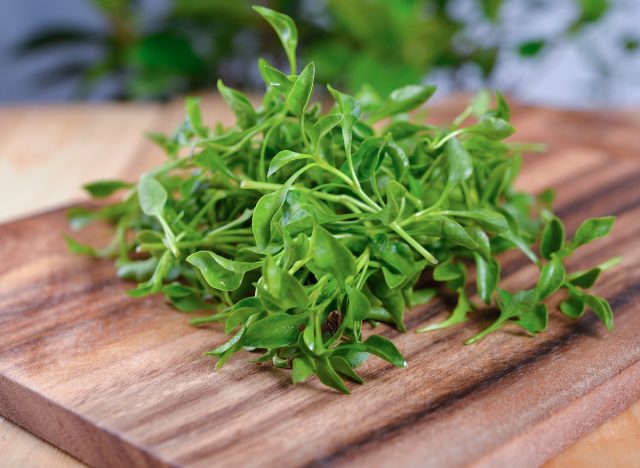
Nutrition (Per 1 cup):
Calories: 4
Fat: 0 g (Saturated Fat: 0 g)
Sodium: 14 mg
Carbs: 0 g (Fiber: 0 g, Sugar: 0 g)
Protein: 1 g
If watercress is a new vegetable to you, then buckle up! It’s about to become one of your favorites. Watercress is an aquatic vegetable, meaning its typically grown near water. And, believe it or not, has been used for centuries as a medicinal aid to treat a variety of conditions.
Research highlights watercress’s impressive nutrient profile with its high amounts of phytonutrients, like terpenes, polphyenols, glucosinolates, and other compounds that offer health promoting benefits. It’s been documented that eating watercress can provide antioxidant, antibacterial, anticancer, anti-inflammatory, and cardioprotective benefits.
Like other leafy greens, watercress is versatile. Enjoy it raw in salads or pestos, cook it into soups, or mix it into combination dishes. For a unique twist, Eat This! dietitian Lauren Manaker suggests tossing it into smoothies for an extra nutrient boost!
